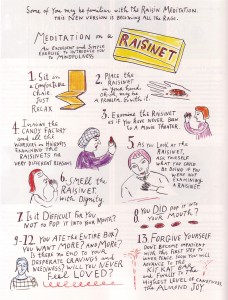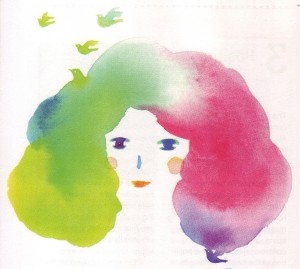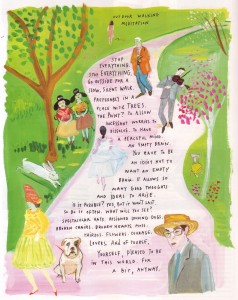Meditation on a Raisinet
 Some of you are probably familiar with the exercise on Mindful Eating that’s often taught on retreat, where little boxes of raisins are passed out at the start of the guided meditation. (They used to pass around a big bowl of loose raisins and everyone just took a handful…but that was back in the old hippy days, before things got corporate.)
Some of you are probably familiar with the exercise on Mindful Eating that’s often taught on retreat, where little boxes of raisins are passed out at the start of the guided meditation. (They used to pass around a big bowl of loose raisins and everyone just took a handful…but that was back in the old hippy days, before things got corporate.)
Anyway, for today I offer Maira Kalman’s variation on that classic meditation, published last year in Mindful magazine. (click to enlarge)
Look What I Found
I took a chance today.
I’ve been thinking about trying to find a qigong class for some time, but kept putting it off while I was still in St. Louis. I’m not sure why, although I think it might’ve had to do with the fact that I’ve been disappointed in the t’ai chi classes I’ve tried. (They were all so serious!)
So I thought, hey, here I am in a new place. With plenty of time. Nowhere to go. Not much to do. I could give it a try! So I did.
And I found a great class where they do something called Five Animal Play (Wuqinxi), which is a very pleasant set of exercises “utilizing deep, smooth breathing matched to movements that mimic the crane, bear, money, deer and tiger. The aim is to enhance the flow of qi (life energy); harmonize the five phases of change (fire, water, earth, wood and metal); strengthen the internal organs, nerves, muscles and bones; prevent and cure diseases; improve the health and vitality of the body, mind and sprit; and prolong life.”
Can’t argue with that.
And besides, it’s fun!
How to Feel at Home
 I have arrived here at my brother’s house in Chapel Hill, where I will be staying for the summer while he and his family are in England. So, basically, this is home for me right now, but of course this is not my home, which got me thinking about what it really means to feel at home.
I have arrived here at my brother’s house in Chapel Hill, where I will be staying for the summer while he and his family are in England. So, basically, this is home for me right now, but of course this is not my home, which got me thinking about what it really means to feel at home.
It sort of means being where you’re comfortable. Which kind of means where your stuff is. Right? Or, at least, where you keep your stuff…when you’re not carrying it around with you.
Which got me thinking about George Carlin’s famous Stuff routine. Which is so funny because it’s so true.
Which got me thinking about how much stuff I’ve got. And then about something Ajahn Sucitto said in one of his talks, about how we can never really have anything because as soon as we get it, we don’t want it, because it’s not really the thing we want, it’s some idyllic state of satisfaction we project onto the thing (he calls it the “glow”), which is not in the thing itself, only in our perception of the thing.
So when we get the thing we want, we feel the momentary relief from the tension of wanting of it, but then right away we realize that what we have is just a thing — that the idyllic state of satisfaction we wanted, which we thought we’d get with the thing, isn’t there — so we didn’t really get what we wanted, and then we feel the lack of that, so we start to want something else.
Hmmm.
So what would it be like not to believe in the idyllic state of satisfaction we think will come with whatever it is that we currently don’t have, but want, and instead to just relax into the state of peace that’s already there when we’re not wanting it.
Maybe that’s what it really means to feel at home.
***
Click here to listen to Ajhan Sucitto’s talk about wanting and having.
For the Difficult Person
 For reasons which will remain unmentioned, I have been thinking a lot lately about the practice of offering metta (goodwill, friendliness) to someone who we in meditation circles euphemistically refer to as “the difficult person.” Traditionally, this person is referred to as the “enemy,” but that seems a bit harsh.
For reasons which will remain unmentioned, I have been thinking a lot lately about the practice of offering metta (goodwill, friendliness) to someone who we in meditation circles euphemistically refer to as “the difficult person.” Traditionally, this person is referred to as the “enemy,” but that seems a bit harsh.
Offering metta is a form of meditation practice that develops healthy, positive, wholesome states of mind — such as kindness and patience — which are clearly beneficial for oneself (these states feel good, for one thing) as well as for others (in that they lead to actions which do not cause harm). We do this practice by thinking of someone who naturally engenders these feelings (a child, a grandparent, someone we admire, or even a pet), then by paying careful attention to what it feels like to be open and friendly toward them and to wish them well. Which nourishes these feelings and helps them develop and grow. And then we practice widening the circle of those we include in our good wishes, adding people we don’t particularly know, people we may have mixed feelings about…and eventually to include everyone, even people we find “difficult.”
This can be a challenge.
Which is why it takes practice.
But it’s important to try to see through the things that we find difficult. Not to overlook them. But to see them in a larger context. To see the positive as well as the negative. And not to fixate on one or the other, but to understand that both these characteristics are a result of situations that are mostly out of our control, and that no matter how annoying, irritating, unpleasant, even destructive these people are, it’s most surely not the only thing that’s true about them.
It’s important to remember this because fixating on the difficulties is not helpful….not for one’s own mental (and physical) well-being…and not for being able to discern the full range of options for dealing with them.
Easier said than done, right?
True. But here’s something that has brought a fresh perspective on this for me. It’s something Rebecca Bradshaw pointed out during metta practice at the retreat here in St. Louis. She said:
Just remember, we are all someone’s difficult person.
Breathing in the Body, the Face, and the Hands
 For wonderfully relaxing instructions on breathing in the body (while standing) and breathing in the face/head/throat (while sitting) listen to the last part of Ahjan Sucitto’s Guided Meditation on Standing (given at the recent retreat at IMS in Barre, MA.)
For wonderfully relaxing instructions on breathing in the body (while standing) and breathing in the face/head/throat (while sitting) listen to the last part of Ahjan Sucitto’s Guided Meditation on Standing (given at the recent retreat at IMS in Barre, MA.)
You can listen or download the talk by clicking here. It’s over an hour long, but don’t worry. The first 10 minutes are chanting and the next 20 minutes are silent.
At about the 30 minute mark, Sucitto invites everyone to stand, then gives about 20 minutes of really lovely, soothing instructions for standing and breathing. Then at about the 49 minute mark, he invites everyone to sit down and gives about 15 minutes of exquisitely subtle instructions on breathing in the head/throat/face (while seated).
These end just after the 1 hour mark with instructions to come back into the lower part of the body, especially the spine, the belly and into the hands. (The rest of the tape is more chanting.) His voice is quite soft as he’s guiding, so I suggest using headphones (or earbuds), if possible.
Enjoy!
***
(image: Pina Bausch, by Maira Kalman)
Release the Face
 The June issue of Mindful magazine offers excellent practice instructions, including these steps to help release tensions that many of us unconsciously carry in our face:
The June issue of Mindful magazine offers excellent practice instructions, including these steps to help release tensions that many of us unconsciously carry in our face:
1. Let the flesh of the cheeks hang (you can lightly visualize weight pulling them down and releasing them.)
2. Allow the forehead to soften (you can lightly visualize the sense of tension draining.)
3. Feel how fine the sensations are in the lips and the tongue (the mouth is the site of some of the most delicate sensations in the body and for this reason has been featured prominently in meditation instructions across many traditions.)
4. After playing with these releases for a while, you will notice that they become second nature. Therefore, over time, shifts in attention become coupled with a softening response that has a powerful effect on the entire system. A good reference point for these adjustments is the face of a baby. When you study the face physiology of babies and other mammals, the complete lack of excess tension, the “receptivity” in the facial tissues, and the general sense of equanimity are striking.
(illustration by Nomoco)
Simplify and Enjoy.
 There are 2 phrases that have “come home with me” from the retreat with Ajahn Sucitto. I say it that way because it definitely feels like these phrases have somehow actively connected with me — taken up residence in my mind/heart/body — in some way that feels….deeply lasting…indelible. Like a psychic tattoo! But deeper and more transformative than that.
There are 2 phrases that have “come home with me” from the retreat with Ajahn Sucitto. I say it that way because it definitely feels like these phrases have somehow actively connected with me — taken up residence in my mind/heart/body — in some way that feels….deeply lasting…indelible. Like a psychic tattoo! But deeper and more transformative than that.
One of the phrases is: Simplify and Enjoy. (The other is: Venerate and Serve, but that’s for another post.)
Sucitto was talking about samadhi practice (concentration, unification of mind) when the phrase Simplify and Enjoy first “stepped through the door.”
“Samadhi is really about simplicity. Simplifying. Cut to the chase. Trim off the discursiveness — the “ifs” and “ands” and “buts” and “maybes” — get to the point; stay with it; get focused. And enjoy. Samadhi is simplification that enables us to more fully enjoy and deepen into what we’re experiencing.”
And there was a certain “ah-ha” quality in hearing that as a way to approach and understand practice. But it was more than that, too. I somehow got, in a very profound way, that the intention to Simplify and Enjoy…..is the way I want to live my life.
***
(image from Cheap Hotels, by Daisann McLane)
Get Rich Quick
 On the first morning of the retreat I sat led by Ajahn Sucitto, after the chanting and candle-lighting ceremony (puja) we participated in, he gave a wonderful talk about the meaning — the intention — of these morning rituals. (You can listen to both the chant and the talk that follows here.)
On the first morning of the retreat I sat led by Ajahn Sucitto, after the chanting and candle-lighting ceremony (puja) we participated in, he gave a wonderful talk about the meaning — the intention — of these morning rituals. (You can listen to both the chant and the talk that follows here.)
I loved what he said about the happiness and pleasure that can come from lifting up our minds when we make offerings in this way:
In meditation we are learning to find pleasure not so much in the contact we have with objects, but in the quality of attention we bring…the ability to rise up, lift up the mind, with intention….We find pleasure not in contact with an object, but in the mind’s action toward the object…..
Lifting the mind up has a pleasant feeling to it…
There are different kinds of lifting up…but the most common and accessible kind comes from service and generosity….
The pleasure of happiness we can get from having things is one kind of pleasure. But the pleasure we can get from giving, serving, offering makes us feel innately rich. We feel wealthy, endowed, empowered, dignified, filled with self-respect.
The Buddha’s teachings are very pragmatic. It’s not just trying to tell us to be good. It’s actually saying: This is really how you get happy….in a particular way that’s calming and steadying, not just exciting.
***
(image from Q-Cards by zolo.com)
Blessings to All
 Because the retreat I just came back from was led by monastics, we did quite a bit of bowing and chanting and other ritualized ways of showing respect and gratitude. I loved it. Especially when we chanted the Verses of Sharing and Aspiration, in which we offered blessings to absolutely everyone…..to those who are friendly, indifferent, or hostile, to gods and evil forces, and even to death itself!
Because the retreat I just came back from was led by monastics, we did quite a bit of bowing and chanting and other ritualized ways of showing respect and gratitude. I loved it. Especially when we chanted the Verses of Sharing and Aspiration, in which we offered blessings to absolutely everyone…..to those who are friendly, indifferent, or hostile, to gods and evil forces, and even to death itself!
Through the goodness that arises from my practice,
May my spiritual teachers and guides of great virtue,
My mother, my father, and my relatives,
The Sun and the Moon, and all virtuous leaders of the world,
May the highest gods and evil forces,
Celestial beings, guardian spirits of the Earth, and the Lord of Death,
May those who are friendly, indifferent, or hostile,
May all beings receive the blessings of my life.
May they soon attain the threefold bliss and realize the Deathless.
Through the goodness that arises from my practice,
And through this act of sharing,
May all desires and attachments quick cease
And all harmful states of mind.
Until I realize Nibanna,
In every kind of birth, may I have an upright mind,
With mindfulness and wisdom, austerity and vigor.
May the sources of delusion not take hold nor weaken my resolve.
The Buddha is my excellent refuge,
Unsurpassed is the protection of the Dhamma,
The solitary Buddha is my noble Lord,
The Sangha is my supreme support.
Through the supreme power of all these,
May darkness and delusion be dispelled.
Take your Mind for a Walk
I got back last night from a wonderful retreat led by Ajahn Sucitto at IMS (Insight Meditation Society) in Barre, Mass. It was beautiful, and inspiring, and I will have much to say about it the days to come, but for now, I’ll just post this illustration by Maira Kalman, titled Outdoor Walking Meditation, which we did a lot of on this retreat. (click on the image to enlarge)
(image from Mindful magazine, August 2013)


